| OCTOBER 2015 |
| Kabukiza (T˘ky˘) |  |
| Dates | 1 ~ 25 October 2015 (Jűgatsu ďkabuki) October Grand Kabuki |
| MatinÚe | |
| Evening |
Dan no Ura Kabuto Gunki (Akoya) |
| Casting |
Living National Treasure Onoe Kikugor˘, Living National Treasure Sakata T˘jűr˘, Living National Treasure Band˘ Tamasabur˘, Living National Treasure Kataoka Nizaemon, Nakamura Tokiz˘, Onoe Sh˘roku, Onoe Kikunosuke, Kataoka Takatar˘, Ichikawa Sadanji, Ichikawa Danz˘, Kataoka Hidetar˘, Band˘ Hikosabur˘, Ichimura Kakitsu, Band˘ Shűch˘, Kawarasaki Gonjűr˘, Ichikawa Unosuke, Band˘ Kamesabur˘, Band˘ Kametoshi, Onoe Matsuya, Nakamura Baishi, Nakamura Mantar˘, Nakamura Kotar˘, Onoe Ukon, Onoe Sakon, Kataoka Matsunosuke |
| Comments |
The 26th anniversary (27th memorial service) of the passing away of Onoe Sh˘roku II is commemorated this month at the Kabukiza. 3 plays are staged to celebrate this anniversary: "Ya-no-Ne", "Bunshichi Mottoi" and "Kamiyui Shinza". Onoe Sh˘roku II's grandson Onoe Sh˘roku IV plays the roles of Soga Gor˘ Tokimune and the kamiyui Shinza in "Ya-no-Ne" and "Kamiyui Shinza". He has already had the opportunity to perform the former role but it is the first time he performs the latter role. Onoe Sh˘roku has already performed several times the role of Shinza's henchman Katsu. The tradition is that you can't perform the role of Shinza unless you've already played the role of Katsu. The tradition is therefore fully respected! An important highlight in these October programs is the staging of "Akoya" with Living National Treasure Band˘ Tamasabur˘ in the leading eponympous role. Young actors Onoe Kikunosuke and Band˘ Kamesabur˘ play the roles of Chichibu no Sh˘ji Shigetada and Iwanaga Saemon Munetsura. It is the first time for both of them! Another interesting feature in these programs is that two Living National Treasure perform minor supporting roles in "Kamiyui Shinza": Kataoka Nizaemon and Onoe Kikugor˘ will play the roles of Kagaya Tobŕ and the bonito-seller Shinkichi!
|
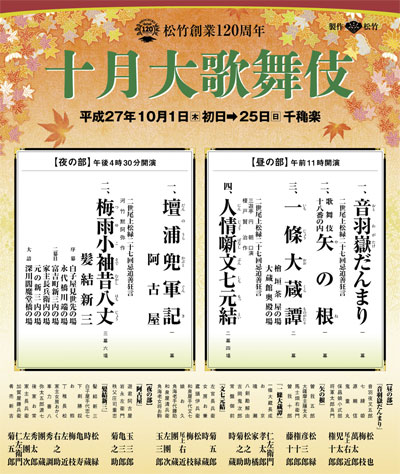 |
| Shinbashi Enbuj˘ (T˘ky˘) |
| Dates | 7 October ~ 25 November 2015 (SűpÔ Kabuki Sekando) Super Kabuki II |
| Program |
ONE PIECE |
| Casting |
Ichikawa Ennosuke, Ichikawa Ukon, Ichikawa Monnosuke, Ichikawa Omez˘, Ichikawa Emisabur˘, Ichikawa Emiya, Ichikawa Shun'en, Ichikawa En'ya, Ichikawa Juen, Ichikawa K˘tar˘, Band˘ Minosuke, Nakamura Hayato |
| Comments |
A hot topic in Fall 2015: Oda Eiichir˘'s internationally popular manga "ONE PIECE" gets his first Kabuki adaptation by Ichikawa Ennosuke. Technically and artistically speaking, it is not Kabuki but SűpÔ Kabuki Sekando (the second generation of SűpÔ Kabuki), a genre created by Ichikawa Ennosuke III and continued by his nephew Ichikawa Ennosuke IV. Most of the actors are Kabuki actors, with 3 non-Kabuki guest actors : Fukushi Seiji, Kashima Noritoshi and Asano Kazuyuki.
|
 |
| National Theatre (T˘ky˘) |
| Dates | 3 ~ 27 October 2015 |
| Program |
|
| Casting |
Nakamura Ganjir˘, Nakamura Baigyoku, Nakamura Kaishun, Nakamura T˘z˘, Ichikawa Komaz˘, Nakamura Kikaku, Nakamura Matsue, Nakamura Kazutar˘, ďtani Tomoemon, Matsumoto Kingo, ďtani Keiz˘, Sawamura Yoshijir˘, Nakamura Jűjir˘ |
| Comments |
"Ise Ondo Koi no Netaba" is staged in a t˘shi ky˘gen production (3 acts; 8 scenes) at the National Theatre. The rarely-staged "Daidaik˘" act is revived! It was staged for the last time in July 1962 at the Kabukiza, more than 53 years ago.
|
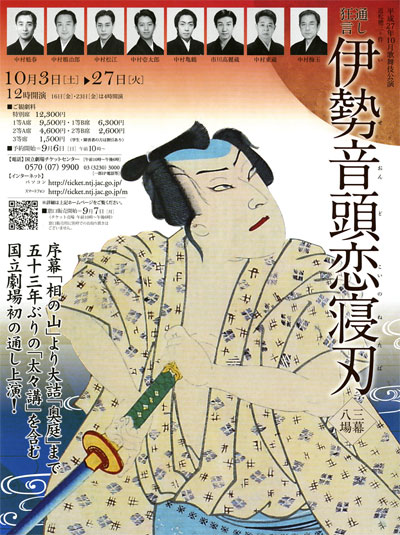 |
| Dates | 24 October 2015 (Dent˘ Kabuki Hozonkai Kenshű Happy˘kai) Training Recital of the Organization for the Preservation of Kabuki |
| Program |
Otanoshimi Zadankai |
| Casting |
Nakamura Kikaku, Nakamura Umemaru, Matsumoto Kin'ya, Nakamura Gannosuke, Sawamura Ujűr˘, Nakamura Toshiya, Nakamura Toshijir˘, Nakamura Harunosuke, Matsumoto Kinji |
| Comments |
16th Training Recital at the National Theatre produced by the Organization for the Preservation of Kabuki. "Otanoshimi Zadankai" (literally "Enjoyable Roundtable Discussion") is a stage speech supervised by the long-time NHK announcer Kasai Seiji.
|
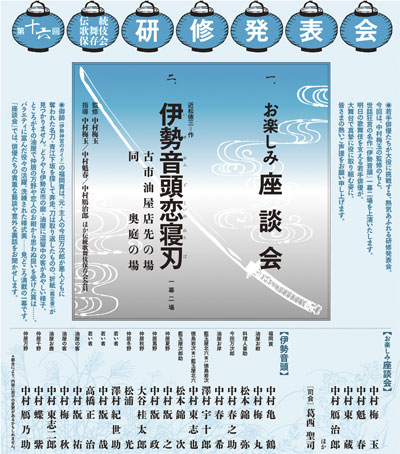 |
| Nagoya (NTK Hall) |
| Dates | 3 ~ 25 October 2015 (Kinshű Nagoya Kaomise) Autumn Brocade Nagoya Face-Showing Program |
| MatinÚe |
Anma to Dorob˘ |
| Evening |
Heike Nyogo no Shima (Shunkan)
|
| Casting |
Living National Treasure Nakamura Kichiemon, Nakamura Shibajaku, Nakamura Kinnosuke, Nakamura Matagor˘, Nakamura Karoku, Nakamura Kash˘, Nakamura Yonekichi, Nakamura Tanenosuke |
| Comments |
The October kaomise programs in Nagoya. As the Misonoza closed in Spring 2013, these programs are staged at the Nihon Tokushu T˘gy˘ Shimin Kaikan for the third time, a venue commonly called NTK Hall in Nagoya.
|
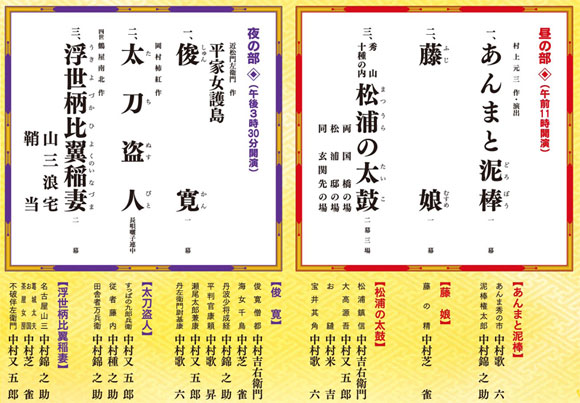 |
| Heisei Nakamuraza (ďsaka) | |
| Dates | 25 October ~ 26 November 2015 |
| MatinÚe |
Shikakubashira Saru no Kusemai |
| Evening | |
| Casting |
Nakamura Kankur˘, Nakamura Shichinosuke, Nakamura Hashinosuke, Nakamura Senjaku, Band˘ Yajűr˘, Kataoka Kamez˘, Band˘ Shingo, Nakamura Tsurumatsu, Nakamura Toranosuke, Nakamura Kunio |
| Comments |
The Heisei Nakamuraza is in ďsaka for the third time. This time, it is a 33-day project, with two different programs. The temporary koshibai look-alike theater is built in the precincts of the ďsaka Castle, in the heart of the Nishi no Maru Park. These performances celebrate the 400th anniversary of the beginning of the Siege of ďsaka, which started in Fall/Winter 2014 (the "Winter Siege" (Fuyu no Jin in Japanese) from November 1614 to January 1615) and ended in Summer 2015 (the summer siege (Natsu no Jin in Japanese) in May and June 1615). The output of this bloody war was the complete destruction of both the ďsaka Castle and the line of Toyotomi Hideyoshi.
|
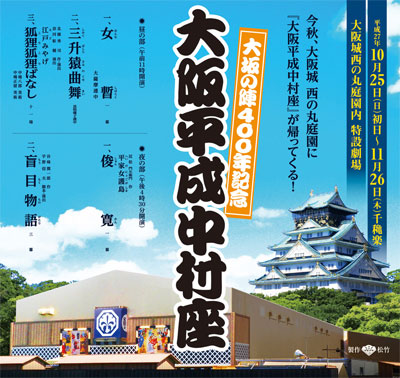 |
| Sh˘chikuza (ďsaka) |
| Dates | 3 ~ 17 October 2015 (Kabuki NEXT) Kabuki NEXT |
| Program |
Aterui |
| Casting | |
| Comments |
A brand new genre was born in the Kabuki world! After Kabuki, Shinkabuki, SűpÔ Kabuki, SűpÔ Kabuki II and Roppongi Kabuki (Sci-Fi Kabuki), here comes alive Kabuki NEXT. The first Kabuki NEXT drama is "Aterui", which was written by Nakajima Kazuki for Ichikawa Somegor˘. It was staged for the first time in August 2002 at the Shinbashi Enbuj˘, starring Ichikawa Somegor˘ with a non-Kabuki cast. In 2002, it was not a Kabuki or a Kabuki NEXT production. In 2015, it was revised to become the first Kabuki NEXT drama in Kabuki history, with a full Kabuki cast. It was staged in July 2015 at the Shinbashi Enbuj˘. The story is about the Emishi warrior Aterui (Ichikawa Somegor˘), who is fighting for the independence of the Emishi people against the Japanese army led by the general Sakanoue no Tamuramaro (Nakamura Kankur˘). The third character of "Aterui" is the Emishi beautiful woman Tate Eboshi (Nakamura Shichinosuke). |
|
|||
| Dates | 29 September ~ 4 October 2015 (JAPAN THEATER) | ||
| Program |
Goaisatsu Kagutsuchi no Mai |
||
| Casting |
Ichikawa Ebiz˘, Kataoka Ichiz˘, Ichikawa Kudanji, ďtani Hiromatsu |
||
| Comments |
A special JAPAN THEATER Kabuki program at the Yachiyoza, starring Ichikawa Ebiz˘. |
||
| Izumo Taisha (Izumo) | |
| Dates | 7 October 2015 (JAPAN THEATER) |
| Program |
Ikari Tomomori Kagutsuchi no Mai |
| Casting |
Ichikawa Ebiz˘, Kataoka Ichiz˘, Ichikawa Kudanji, ďtani Hiromatsu |
| Comments |
A special JAPAN THEATER Kabuki program at the Izumo Taisha, starring Ichikawa Ebiz˘. The performances are done on a special stage built within the shrine. |
| Nikk˘ T˘sh˘gű (Nikk˘) | |
| Dates | 10 ~ 11 October 2015 (JAPAN THEATER) |
| Program |
Ikari Tomomori Kagutsuchi no Mai |
| Casting |
Ichikawa Ebiz˘, Kataoka Ichiz˘, Ichikawa Kudanji, ďtani Hiromatsu |
| Comments |
A special JAPAN THEATER Kabuki program at the Nikk˘ T˘sh˘gű, starring Ichikawa Ebiz˘. The performances are done on a special stage built within the shrine. |
|
|||
| Dates | 23 ~ 26 October 2015 (JAPAN THEATER) | ||
| Program |
Kagutsuchi no Mai Funa Benkei |
||
| Casting |
Ichikawa Ebiz˘, Kataoka Ichiz˘, Ichikawa Kudanji, ďtani Hiromatsu |
||
| Comments |
A special JAPAN THEATER Kabuki program at the Minamiza, starring Ichikawa Ebiz˘. The third item in the program is a N˘ drama performed (hann˘, not the full N˘ performance) by two N˘ actors: Kanze Tetsunoj˘ IX and Katayama Kur˘emon X. |
||
| NHK Hall (T˘ky˘) | |
| Dates | 28 October 2015 (Koten Gein˘ Kansh˘ Kai) |
| Program | |
| Casting |
Living National Treasure Onoe Kikugor˘, Ichikawa Sadanji, Kawarasaki Gonjűr˘, Nakamura Baishi, Onoe Ukon |
| Comments |
42nd edition of Koten Gein˘ Kansh˘ Kai (literally the "Classics Entertainment Appreciation Association"), a yearly performance produced by the National TV network NHK. The program includes traditional music, one ky˘gen and one Kabuki dance-drama.
|
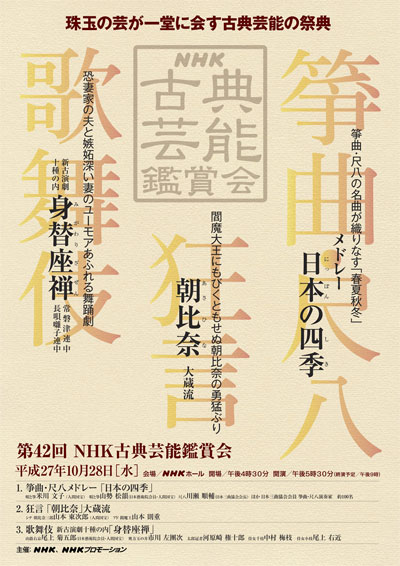 |
|
|||
| Dates | 29 October ~ 3 November 2015 Band˘ Tamasabur˘ Special Dance Performances |
||
| Program |
Keisei |
||
| Casting |
Living National Treasure Band˘ Tamasabur˘ |
||
| Comments |
A special Buy˘ program starring the amazing Living National Treasure onnagata Band˘ Tamasabur˘ in Yamaga at the Yachiyoza, a traditional wooden-built theater. The first item in the program is a k˘j˘.
|
||
|
|
| Contact | Main | Top | Updates | Actors | Plays | Playwrights | Programs | Links | FAQ | Glossary | Chronology | Illustrations | Prints | Characters | Derivatives | Theaters | Coming soon | News |